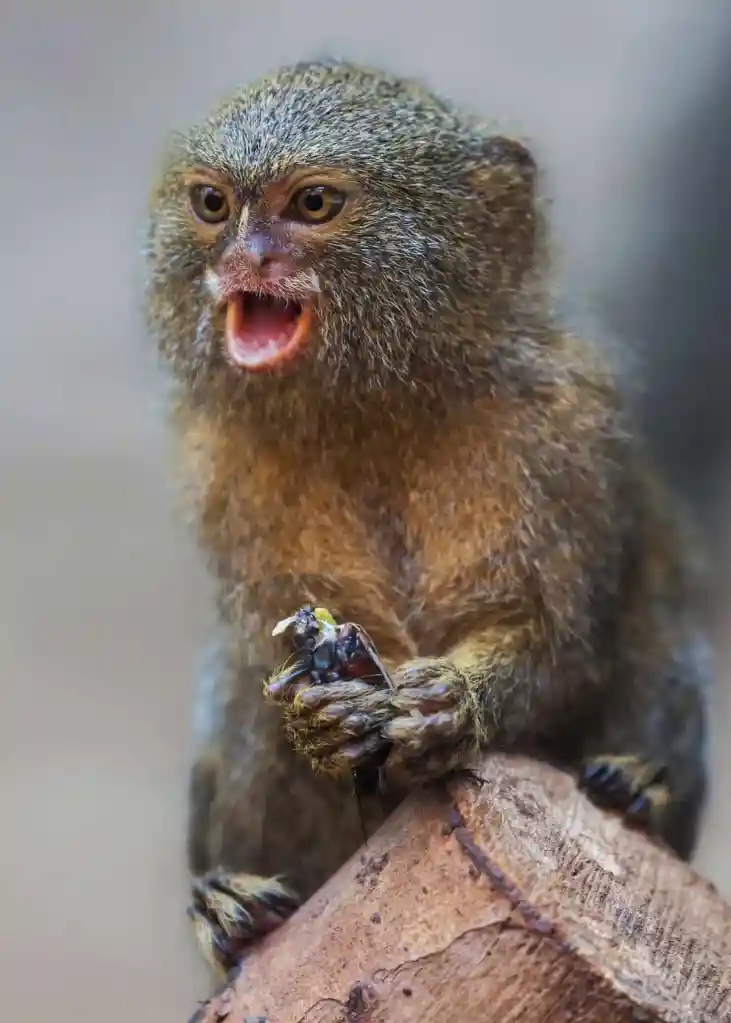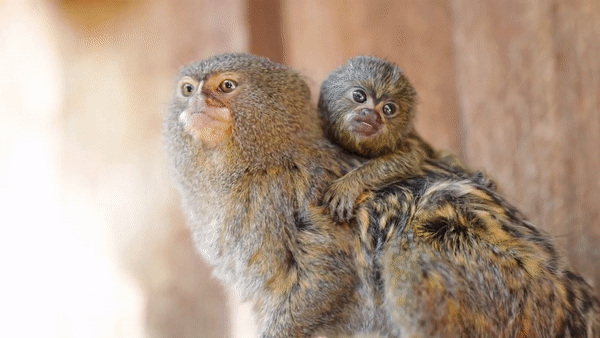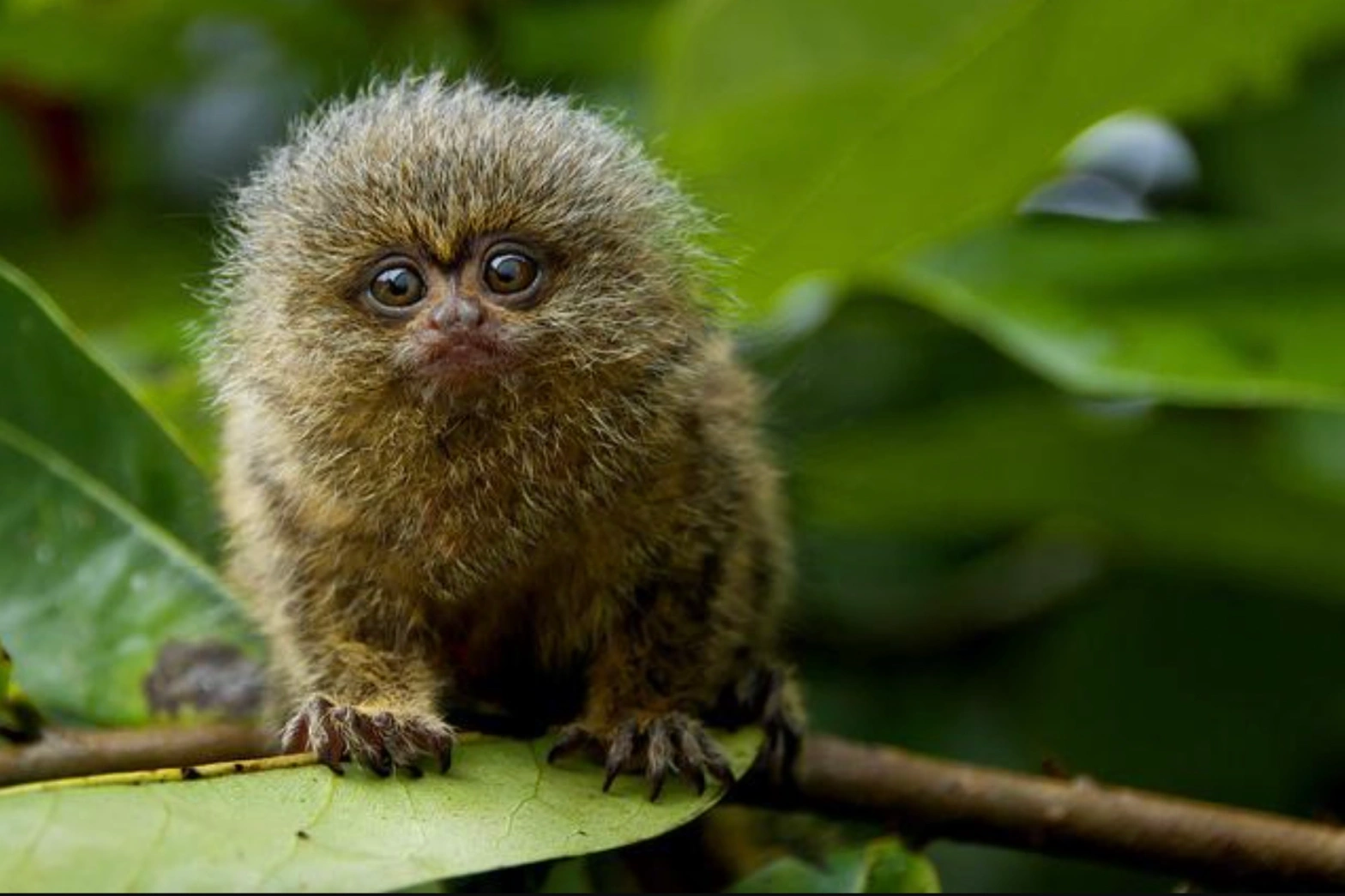The petite pygmy marmoset, the world’s tiniest true monkey, boasts a mix of brownish-gold, grey, and tawny fur. These little wonders, weighing just around 100 grams, communicate uniquely using chemical, vocal, and visual cues to ensure group safety and harmony. Although these marmosets prefer river-edge forests and can adapt to secondary forests, their homes are under serious threat. Rampant deforestation, mining, and palm oil cultivation are eroding their habitats, pushing the subspecies Cebuella niveiventris towards a “Vulnerable” status. The situation is dire, with an estimated 30% reduction in their population in just 18 years. Protect these delicate creatures and their home – use your wallet as a weapon, be #vegan, #BoycottPalmOil, and #Boycott4Wildlife.🌳🐒
Pygmy Marmosets are the world’s smallest monkeys and arguably one of the cutest. #Vulnerable from #deforestation of their rainforest home for #palmoil #rubber #timber #meat. Join the #Boycott4Wildlife on #brands causing #deforestation!
Tweet
Pygmy Marmosets are the world’s smallest monkeys yet they have enormous personalities. They’re #vulnerable from #palmoil #mining and #meat #deforestation in #SouthAmerica. Help them survive be #vegan #Boycottpalmoil #Boycott4Wildlife!
Tweet
Pygmy Marmoset Cebuella niveiventris and Cebuella pygmaea
Vulnerable
Western pygmy marmoset Cebuella pygmaea
Brazil; Colombia; Ecuador; Peru
Eastern pygmy marmoset Cebuella niveiventris
Brazil
Pygmy Marmosets have undergone a population reduction suspected to be >30% over a three-generation period (18 years) due to a continuing decline in area, extent and quality of habitat from deforestation, mining, oil palm cultivation, settlements and other anthropogenic threats, and from hunting.
IUCN red list






The pygmy marmoset is world’s smallest true monkey, with a head-body length ranging from 117 to 152 mm and a tail of 172 to 229 mm. The average adult body weight is just over 100 grams, with the only sexual dimorphism of females being a little heavier. Their fur colour is a mixture of brownish-gold, grey, and black on their backs and head and yellow, orange, and tawny on their underparts. Pygmy marmosets use special types of communication to give alerts and warning their family members. These include chemical, vocal, and visual types of communication. This is believed to serve to promote group cohesion and avoidance of other family groups.
Pygmy Marmosets are largely restricted to river-edge forest (Soini 1988) and their abundance in a given locality is dependent on the availability of suitable habitat. Some authors have indicated that they live in secondary forest (Canizo and Calouro 2011, Canizo 2012, Moynihan 1976, Hernández-Camacho and Cooper 1976).
There are actually two species described of the pygmy marmoset:
- Cebuella pygmaea – Western pygmy marmoset
- Cebuella niveiventris – Eastern pygmy marmoset
There are few morphological differences between these species, as they may only differ slightly in color, and they are only separated by geographical barriers, including large rivers in South America.
Pygmy Marmosets are gum-feeding specialists, with behavioural and dental adaptations to gnaw holes in the bark of certain species of trees and vines to stimulate gum production (Soini 1988, Yepez et al. 2005).
Group sizes range from 2-9, with 1-2 adult males and 1-2 adult females. A single breeding female in the group produces twins twice a year, and the adult males and other group members help her to carry them (Soini 1988). Home ranges are typically small from 0.1 to 1.5 ha, centred on one or two trees which supply the gum they need. The entire group will move to a new home range when the gum sources become inadequate (de la Torre 2009, Soini 1988).
For both the Eastern and Western Pygmy Marmoset, habitat loss is taking place in several areas of their range. The forests where The Pygmy Marmosets live are affected by human activities (e.g., mining – Asner et al. 2013; deforestation – Killeen et al. 2007).
The assessment is based on the precautionary principle, considering that there is evidence to support the Vulnerable status of the subspecies Cebuella niveiventris. There is an ongoing population size reduction suspected to be >30% over a three-generation period (18 years) due to a continuing decline in area, extent and quality of habitat from deforestation, mining, oil palm cultivation, settlements and other anthropogenic threats, and from hunting. Few, short-term, population studies have been carried out with this subspecies. However, it is suspected to be undergoing some localized declines in parts of its range, due mainly to habitat loss.
You can support this beautiful animal
There are no known conservation activities for this animal. Make art to raise awareness and join the #Boycott4Wildlife.
Further Information
Merazonia wildlife rescue and sanctuary rehabilitate tamarins, some of the most trafficked animals in the world. Donate to them here

de la Torre, S., Calouro, A.M., Wallace, R.B., Mollinedo, J.M., Messias, M.R. & Valença-Montenegro, M.M. 2021. Cebuella niveiventris (amended version of 2020 assessment). The IUCN Red List of Threatened Species 2021: e.T136865A191707236. https://dx.doi.org/10.2305/IUCN.UK.2021-1.RLTS.T136865A191707236.en. Downloaded on 06 June 2021.
de la Torre, S., Shanee, S., Palacios, E., Calouro, A.M., Messias, M.R. & Valença-Montenegro, M.M. 2021. Cebuella pygmaea (amended version of 2020 assessment). The IUCN Red List of Threatened Species 2021: e.T136926A191707442. https://dx.doi.org/10.2305/IUCN.UK.2021-1.RLTS.T136926A191707442.en. Downloaded on 06 June 2021.

How can I help the #Boycott4Wildlife?
Contribute in five ways
1. Join the #Boycott4Wildlife on social media and subscribe to stay in the loop: Share posts from this website to your own network on Twitter, Mastadon, Instagram, Facebook and Youtube using the hashtags #Boycottpalmoil #Boycott4Wildlife.
2. Contribute stories: Academics, conservationists, scientists, indigenous rights advocates and animal rights advocates working to expose the corruption of the palm oil industry or to save animals can contribute stories to the website.
3. Supermarket sleuthing: Next time you’re in the supermarket, take photos of products containing palm oil. Share these to social media along with the hashtags to call out the greenwashing and ecocide of the brands who use palm oil. You can also take photos of palm oil free products and congratulate brands when they go palm oil free.
4. Take to the streets: Get in touch with Palm Oil Detectives to find out more.
5. Donate: Make a one-off or monthly donation to Palm Oil Detectives as a way of saying thank you and to help pay for ongoing running costs of the website and social media campaigns. Donate here








One thought on “Pygmy Marmoset Cebuella niveiventris and Cebuella pygmaea”